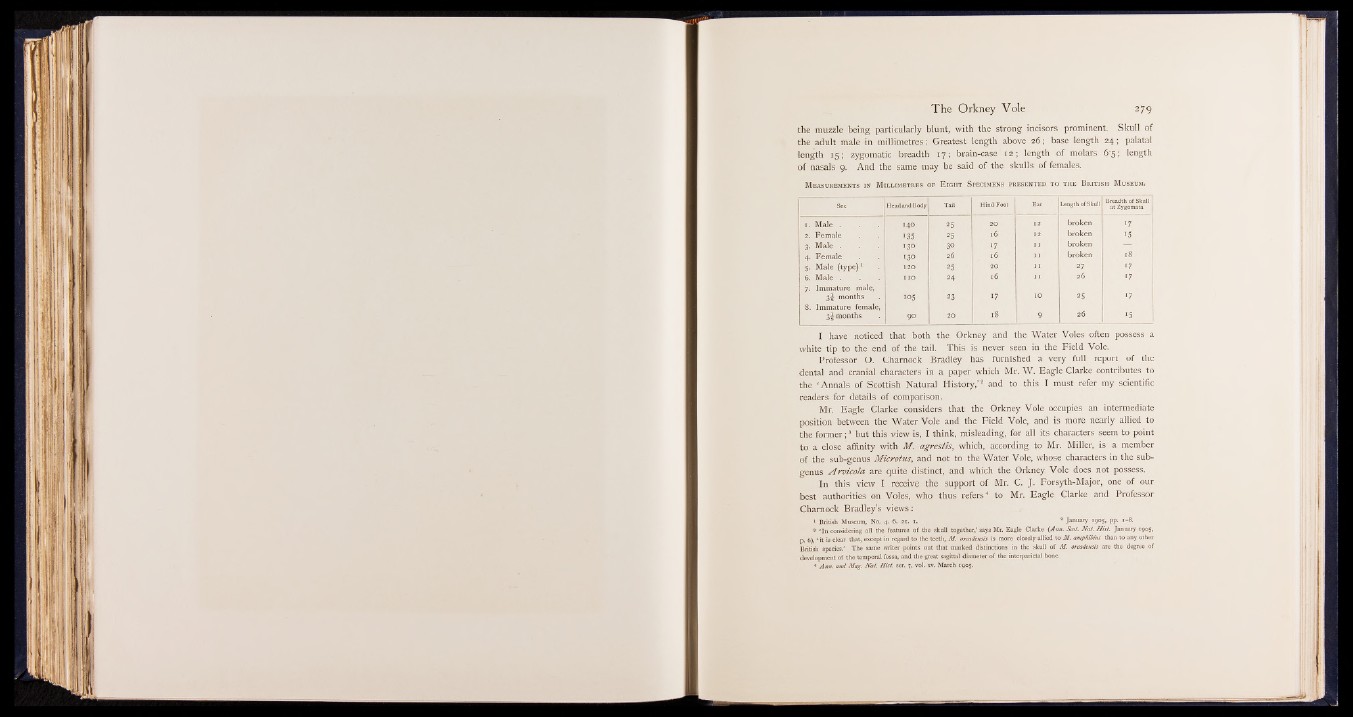
the muzzle being particularly blunt, with the strong incisors prominent. Skull of
the adult male in millimetres: Greatest length above 26; base length 24 ; palatal
length 1 5 ; zygomatic breadth 17 ; brain-case 1 2 ; length of molars 6-5; length
of nasals 9. And the same may be said of the skulls of females.
M easu r em en ts in M il l im e t r e s of E ight S pecimens pr e sen t ed to th e B rit ish M useums
Sex HeadandBody Tail Hind Foot Ear Length of Skull Breadth of Skull
at Zygomata
i . Male . 140 - 2 5 20 12 broken 17
2. Female 135 25 16 12 broken 15
3. Male . 130 30 17 1 1 broken ; ' — .
4. Female 13 0 2$ 16 . i i ■ broken 18
El Male (typ e)1 12 0 25 20 1 1 27 17
6. Male . n o 24 l 6 1 1 26 17
7. Immature male,
3-J months 105 23 17 10 25 17
8. Immature female,
3^ months 90 20 l 8 9 26 15
I have noticed that both the Orkney and the Water Voles often. possess a
white tip to the end of the tail. This is never seen in the Field Vole.
Professor O. Charnock Bradley has furnished a very full report of the
dental and cranial characters in a paper which Mr. W. Eagle Clarke contributes to
the ‘ Annals of Scottish Natural History,’ 2 and to this I must refer my scientific
readers for details of comparison.
Mr. Eagle Clarke considers that the Orkney Vole occupies an intermediate
position between the Water Vole and the Field Vole, and is more nearly allied to
the. former;8 but this view is, I think, misleading, for all its characters seem to point
to a close affinity with M. agrestis, which, according to Mr. Miller, is a member
of the sub-genus Microtus, and not to the Water Vole, whose characters in the subgenus
A rvico la are quite distinct, and which the Orkney Vole does not possess.
In this view I receive the support of Mr. C. J . Forsyth-Major, one of our
best authorities on Voles, who thus refers4 to Mr. Eagle Clarke and Professor
Charnock Bradley’s views:
1 British Museum, No. 4- 6. 2 1. 1. * January 1905, pp. 1-8.
3 <jn considering all the features of the skull together,’ says Mr. Eagle Clarke (Ann. Scot. Nat. Hist. January 1905,
p. 6), ‘ it is clear that, except in regard to the teeth, M. orcadensis is more closely allied to M. amphibius than to any other
British species.’ The same writer points out that marked distinctions in the skull of M. orcadensis are the degree of
development of the temporal fossa, and the great sagittal diameter of the interparietal bone.
* Ann. and Mag. Nat. Hist. ser. 7, vol. xv. March 1905.